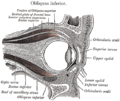Eyelid

Eyelid[edit]
The eyelid is a delicate, multi-layered fold of skin designed to shield and safeguard the eye. A crucial component of the visual system, the eyelid, apart from the prepuce and the labia minora, boasts some of the thinnest skin in the human body. This article elaborates on its structure, function, and relevance to overall ocular health.

Function[edit]
The core functions of the eyelid include:
- Regularly distributing tears and other secretions across the eye's surface, ensuring the cornea remains constantly moistened.
- Preventing the eyes from drying while asleep.
- Protecting the eye from dust, external particles, and moisture, primarily through the blink reflex.
- Serving as a defense mechanism against potential foreign bodies.
Notably, the human eyelid is adorned with a line of eyelashes, which bolster its protective capacities, especially against foreign particles and sweat.
Anatomy[edit]
File:Slide2www.JPG|Extrinsic eye muscle. Nerves of orbita. Deep dissection]]
Layers[edit]
From the outermost to the innermost layer, the eyelid comprises:
- Skin: Comparable to skin elsewhere on the body but is notably thin and has a higher concentration of pigment cells. In certain conditions, these cells may migrate, causing discoloration.
- Subcutaneous tissue
- Orbicularis oculi: A muscle responsible for eyelid movement.
- Orbital septum and tarsal plates: Provide structural support.
- Palpebral conjunctiva: A mucous membrane that lines the inner surface of the eyelid.
Within the eyelid, the meibomian glands secrete the lipid component of the tear film, essential for eye lubrication.
Innervation[edit]
Sensory innervation for the eyelids is as follows:
- Upper eyelids: Supplied by the infratrochlear, supratrochlear, supraorbital, and lacrimal nerves from the ophthalmic branch (V1) of the trigeminal nerve (CN V).
- Lower eyelids: Primarily supplied by branches of the infraorbital nerve from the maxillary branch (V2) of the trigeminal nerve, with the infratrochlear nerve serving the medial angle.
Blood Supply[edit]
Blood is delivered to the eyelids through two arterial arches in both the upper and lower lids. These arches are formed via anastomoses between the lateral and medial palpebral arteries, derivatives of the lacrimal and ophthalmic arteries respectively.
Etymology[edit]
"Palpebral" and "blepharal" are terms pertaining to the eyelids. Their origins and usage help in the anatomical and clinical description of conditions and procedures linked with the eyelid.
See also[edit]
- Eye anatomy
- Blink reflex
- Ocular system
- Blepharospasm
- Cellulitis
- Chalazion
- Dermatochalasis
- Ectropion
- Entropion
- Hay-Wells syndrome
- Nictitating membrane
- Ptosis
- Stye (Hordeolum)
Additional images[edit]
-
Bloodvessels of the eyelids, front view
-
Horizontal section through the eye of an eighteen days' embryo rabbit. X 30
-
Sagittal section of right orbital cavity
-
Sagittal section through the upper eyelid
-
The tarsi and their ligaments. Right eye; front view
-
The lacrimal apparatus. Right side
| Anatomy of the globe of the human eye | ||||||||||||||||||
|---|---|---|---|---|---|---|---|---|---|---|---|---|---|---|---|---|---|---|
|
|
|
|
| The orbit of the eye | ||||||||||
|---|---|---|---|---|---|---|---|---|---|---|
|
| Anatomy and morphology | ||||||||||
|---|---|---|---|---|---|---|---|---|---|---|
|
Ad. Transform your life with W8MD's Budget GLP-1 injections from $75


W8MD offers a medical weight loss program to lose weight in Philadelphia. Our physician-supervised medical weight loss provides:
- Weight loss injections in NYC (generic and brand names):
- Zepbound / Mounjaro, Wegovy / Ozempic, Saxenda
- Most insurances accepted or discounted self-pay rates. We will obtain insurance prior authorizations if needed.
- Generic GLP1 weight loss injections from $75 for the starting dose.
- Also offer prescription weight loss medications including Phentermine, Qsymia, Diethylpropion, Contrave etc.
NYC weight loss doctor appointmentsNYC weight loss doctor appointments
Start your NYC weight loss journey today at our NYC medical weight loss and Philadelphia medical weight loss clinics.
- Call 718-946-5500 to lose weight in NYC or for medical weight loss in Philadelphia 215-676-2334.
- Tags:NYC medical weight loss, Philadelphia lose weight Zepbound NYC, Budget GLP1 weight loss injections, Wegovy Philadelphia, Wegovy NYC, Philadelphia medical weight loss, Brookly weight loss and Wegovy NYC
|
WikiMD's Wellness Encyclopedia |
| Let Food Be Thy Medicine Medicine Thy Food - Hippocrates |
Medical Disclaimer: WikiMD is not a substitute for professional medical advice. The information on WikiMD is provided as an information resource only, may be incorrect, outdated or misleading, and is not to be used or relied on for any diagnostic or treatment purposes. Please consult your health care provider before making any healthcare decisions or for guidance about a specific medical condition. WikiMD expressly disclaims responsibility, and shall have no liability, for any damages, loss, injury, or liability whatsoever suffered as a result of your reliance on the information contained in this site. By visiting this site you agree to the foregoing terms and conditions, which may from time to time be changed or supplemented by WikiMD. If you do not agree to the foregoing terms and conditions, you should not enter or use this site. See full disclaimer.
Credits:Most images are courtesy of Wikimedia commons, and templates, categories Wikipedia, licensed under CC BY SA or similar.
Translate this page: - East Asian
中文,
日本,
한국어,
South Asian
हिन्दी,
தமிழ்,
తెలుగు,
Urdu,
ಕನ್ನಡ,
Southeast Asian
Indonesian,
Vietnamese,
Thai,
မြန်မာဘာသာ,
বাংলা
European
español,
Deutsch,
français,
Greek,
português do Brasil,
polski,
română,
русский,
Nederlands,
norsk,
svenska,
suomi,
Italian
Middle Eastern & African
عربى,
Turkish,
Persian,
Hebrew,
Afrikaans,
isiZulu,
Kiswahili,
Other
Bulgarian,
Hungarian,
Czech,
Swedish,
മലയാളം,
मराठी,
ਪੰਜਾਬੀ,
ગુજરાતી,
Portuguese,
Ukrainian








